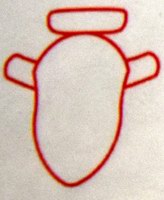Indice dei Musei
presenti in miti3000
Napoli Museo Nazionale - Piano -1 - Sala XXI La Mummificazione
- Intro sala XIX
- Sala XIX
- Intro sala XX
- Sala XX
- Intro sala XXI
- Sala XXI vetrina 49
- Sala XXI vetrina 50
- Sala XXI vetrina 51
- Sala XXI vetrina 52
- Sala XXI vetrina 53-54
- Sala XXI vetrine 55-56
- Sala XXI vetrine 57 - 58
- Sala XXI vetrine 60 - 61
- Sala XXI vetrine 62 - 63
- Intro Sala XXII
- Sala XXII vetrine 70 - 78
- Sala XXII vetrine 79 - 84
- Intro Sala XXIII
- Sala XXIII v.87-92
- Sala XXIII v.93-97
- Sala XXIII v.98-104
Testo
Sala XXI La Mummificazione vetrine 55 - 56
Amuleto cuore (Ib)
Il cuore, ritenuto la sede dei pensieri e delle emozioni. nel giudizio dopo la morte veniva pesato su una bilancia, avendo come contrappeso una piuma (Maat), simbolo di ordine, verità e giustizia. Se il suo peso non superava quello della piuma, l’esito del giudizio era positivo.
Heart amulet (ib)
The heart was regarded as the site of thoughts and emotions. In the judgment after death, the heart was weighed on a scales against a feather (Maat), the symbol of order truth, and justice. If it did not outweigh the plume, the outcome of the judgment was positive.
Amuleto Uadj (papiro)
In faïence o in smeraldo, posto sul collo del defunto, assicurava il rinnovo della vita e della gioventù.
Wadj amulet (papyrus)
It was usually made of faience or emerald. Placed on the deceased’s neck, it ensured the renewal of life and youth.
Amuleto Sema
Rappresenta i polmoni e la trachea. Si pensava desse la capacità di respirare liberamente e di prolungare l”esistenza del soffio vitale nel corpo. Veniva usato per indicare gli organi raffigurati e per il vocabolo dallo stesso suono che significa «unire». Come amuleto è simbolo dell’unione e del piacere fisico.
Sema amulet
It represents the lungs and windpipe. It wasb believed to grant the ability to breathe freely and prolong the persistence of the breath of of life in their body. It was used to designate the depicted organs and the like-sounding word meaning «to unite, join». As an amulet it symbolizes union and physical pleasure.
Posiziona il mouse sulle immagini per avere pi¨ informazioni, Cliccaci sopra per l'ingrandimento.
Place the mouse on the images to get more information, click on it to enlarge




Vetrina 56
Amuleto Sciuty
Le due piume del copricapo del dio Amon. Simbolo di aria e luce, l'amuleto indica il potere di generare e la virilitÓ.
Shuty amulet
The two plumes of the crown of the god Amon. A symbol of air and light, ithe amulet signifies the power of generation and virility.
Amuleto Ren
Cartiglio o «amuleto del nome». Circondava il nome del sovrano per preservarlo da influenze maligne. ╚ comunemente realizzato in lapislazzuli o in pietra scura.
Pen amulet
Cartouche or «name amulet». It surrounded the name of the king to preserve him from evil influences. It is commonly made of lapis lazuli or dark stone.
Amuleto Aper
Interpretato come stoffa, nastro. La sua funzione sembra connessacon l'elargizione della felicitÓ.
Aper amulet
Interpreted as picturing a piece of cloth or ribbon. Its function may have to do with the granting of happiness.
Amuleto poggiatesta (Ures)
Comunemente realizzato in ematite. La sua funzione era quella di tener sollevata la testa della mummia e di impedirne la rimozione dal corpo (Cap. CLXVI del Libro dei Morti).
Headrest amulet (weres)
Commonly made of hematite. Their function was to keep the head of the mummy raised and and prevent its removal from the body (Chap. CLXVI of the Book of the Dead).
Amuleti rappresentanti simboli
Pietre varie e faïence. Epoca Tarda (664-332 a.C.)
1-20: sciuty. 21-24: ren. 25-29: aper. 30-35: poggiatesta (ures).
Collezione Picchianti
Amulets representing symbols
Various stones and faience. Late Period (664-332 BC)
1-20: shuty. 21-24:rsen. 25-29: aper. 30-35: headrest (weres).
Picchianti collection
Posiziona il mouse sulle immagini per avere pi¨ informazioni, Cliccaci sopra per l'ingrandimento.
Place the mouse on the images to get more information, click on it to enlarge


Fotografie di Giorgio Manusakis







